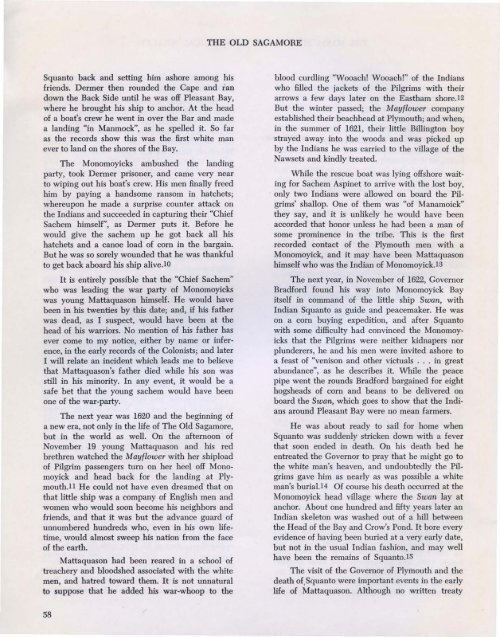Volume 19, 19(4)
Volume 19, 19(4)
Volume 19, 19(4)
Create successful ePaper yourself
Turn your PDF publications into a flip-book with our unique Google optimized e-Paper software.
Squanto back and setting him ashore among his<br />
friends. Dermer then rounded the Cape and ian<br />
down the Back Side until he was off Pleasant Bay,<br />
where he brought his ship to anchor. At the head<br />
of a boat's crew he went in over the Bar and made<br />
a landing "in Manmock", as he spelled it. So far<br />
as the records show this was the first white man<br />
ever to land on the shores of the Bay.<br />
The Monomoyicks ambushed the landing<br />
party, took Dermer prisoner, and came very near<br />
to wiping out his boat's crew. His men finally freed<br />
him by paying a handsome ransom in hatchets;<br />
whereupon he made a surprise counter attack on<br />
the Indians and succeeded in capturing their "Chief<br />
Sachem himself', as Dermer puts it. Before he<br />
would give the sachem up he got back all his<br />
hatchets and a canoe load of corn in the bargain.<br />
But he was so sorely wounded that he was thankful<br />
to get back aboard his ship alive.10<br />
It is entirely possible that the "Chief Sachem"<br />
who was leading the war party of Monomoyicks<br />
was young Mattaquason himself. He would have<br />
been in his twenties by this date; and, if his father<br />
was dead, as I suspect, would have been at the<br />
head of his warriors. No mention of his father has<br />
ever come to my notice, either by name or inference,<br />
in the early records of the Colonists; and later<br />
I will relate an incident which leads me to believe<br />
that Mattaquason's father died while his son was<br />
still in his minority. In any event, it would be a<br />
safe bet that the young sachem would have been<br />
one of the war-party.<br />
The next year was 1620 and the beginning of<br />
a new era, not only in the life of The Old Sagamore,<br />
but in the world as well. On the afternoon of<br />
November <strong>19</strong> young Mattaquason and his red<br />
brethren watched the Mayflower with her shipload<br />
of Pilgrim passengers turn on her heel off Monomoyick<br />
and head back for the landing at Plymouth.ll<br />
He could not have even dreamed that on<br />
that little ship was a company of English men and<br />
women who would soon become his neighbors and<br />
friends, and that it was but the advance guard of<br />
unnumbered hundreds who, even in his own lifetime,<br />
would almost sweep his nation from the face<br />
of the earth.<br />
Mattaquason had been reared in a school of<br />
treachery and bloodshed associated with the white<br />
men, and hatred toward them. It is not unnatural<br />
to suppose that he added his war-whoop to the<br />
58<br />
THE OLD SAGAMORE<br />
blood curdling "Wooach! Wooach!" of the Indians<br />
who filled the jackets of the Pilgrims with their<br />
arrows a few days later on the Eastham shore.12<br />
But the winter passed; the Mayflower company<br />
established their beachhead at Plymouth; and when,<br />
in the summer of 1621, their little Billington boy<br />
strayed away into jthe woods and was picked up<br />
by the Indians he was carried to the village of the<br />
Nawsets and kindly treated.<br />
While the rescue boat was lying offshore waiting<br />
for Sachem Aspinet to arrive with the lost boy,<br />
only two Indians were allowed on board the Pilgrims'<br />
shallop. One of them was "of Manamoick"<br />
they say, and it is unlikely he would have been<br />
accorded that honor unless he had been a man of<br />
some prominence in the tribe. This is the first<br />
recorded contact of the Plymouth men with a<br />
Monomoyick, and it may have been Mattaquason<br />
himself who was the Indian of Monomoyick13<br />
The next year, in November of 1622, Governor<br />
Bradford found his way into Monomoyick Bay<br />
itself in command of the little ship Swan, with<br />
Indian Squanto as guide and peacemaker. He was<br />
on a corn buying expedition, and after Squanto<br />
with some difficulty had convinced the Monomoyicks<br />
that the Pilgrims were neither kidnapers nor<br />
plunderers, he and his men were invited ashore to<br />
a feast of "venison and other victuals . . . in great<br />
abundance", as he describes it. While the peace<br />
pipe went the rounds Bradford bargained for eight<br />
hogsheads of corn and beans to be delivered on<br />
board the Swan, which goes to show that the Indians<br />
around Pleasant Bay were no mean farmers.<br />
He was about ready to sail for home when<br />
Squanto was suddenly stricken down with a fever<br />
that soon ended in death. On his death bed he<br />
entreated the Governor to pray that he might go to<br />
the white man's heaven, and undoubtedly the Pilgrims<br />
gave him as nearly as was possible a white<br />
man's buria1.14 Of course his death occurred at the<br />
Monomoyick head village where the Swan lay at<br />
anchor. About one hundred and fifty years later an<br />
Indian skeleton was washed out of a hill between<br />
the Head of the Bay and Crow's Pond. It bore every<br />
evidence of having been buried at a very early date,<br />
but not in the usual Indian fashion, and may well<br />
have been the remains of Squanto.l5<br />
The visit of the Governor of Plymouth and the<br />
death of, Squanto were important events in the early<br />
life of Mattaquason. Although no written treaty

















